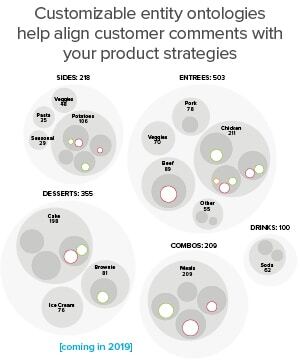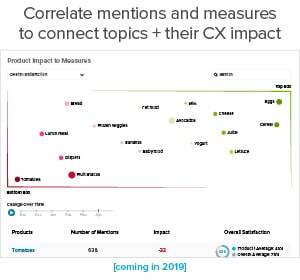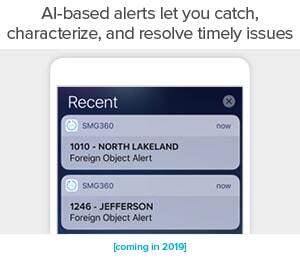Bridge the Quantitative–Qualitative Gap in CX Feedback with Text Analytics
Published on May 09, 2019

When it’s your job to listen to customers and act on their feedback, you absolutely have to be using text analytics. The world’s most successful brands know: it’s the surest way to glean rich insights from customer feedback, and the only way to get quantitative data from qualitative input.
In a previous blog, we discussed how our recent and upcoming text analytics innovations deliver top-tier accuracy, powerful reporting, and next-level insights to help CX pros get the most from their open-ended feedback. Next we’ll take a look at 3 more ways you can use intuitive text analytics technology to add critical context to CX scores:
1. Create Custom Groupings for Targeted Analysis
Unlike the quantitative data you’re collecting through the customer experience measurement (CEM) survey, findings from unstructured data don’t always fit into a neat little box. More often, they’re spread across the wide array of products, services, and initiatives you’re trying to track—which means you need to ensure they align with how you’re tracking them.
That’s where custom entity ontologies come in. Entity ontologies essentially serve as brand-specific encyclopedias—ensuring the lingo consumers use lines up with your own terminology.

2. Understand Comment Correlations to Performance
Just like survey scores don’t exist in a vacuum, neither do comments—and you need to understand the relationship between both to get the full picture. Every iteration of the customer experience offers an opportunity to gain a more nuanced understanding of where to improve.
Whether it’s specific products, new service standards, or recent operational changes, noting when customers call out those experiential variables—and more importantly, understanding how they impact important measures—is mission-critical to building an innovative strategy that resonates.

3. Use Predictive Analytics to Stay Ahead
While every comment matters, some carry more weight than others—especially when they pertain to issues that rarely pop up. While things like foodborne illness, employee misconduct, and operational hazards may only appear once in tens of thousands of comments, identifying and addressing those issues is paramount.
Advanced text analytics tools enable brands to identify and alert on low-frequency, high-impact events. Even more importantly, AI technology identifies the mentions in real time and—depending on the scope of the issue—triggers the appropriate actions. Whether it’s providing managers with relevant coaching information or diagnosing and relaying potentially system-wide issues to central customer care teams, AI-based alerts help keep brands one step ahead.

Unveil Insights Hiding in Plain Text
While the quantitative data from your CEM program is invaluable, it’s often the customer comments that help you answer questions you never thought to ask. Fueled by data science, text analytics tools help brands maximize their CX feedback.
Learn more about how text analytics tools can help you turn open-ended feedback into meaningful change. Download the guide: 6 ways text analytics delivers better insights for better business outcomes
Related articles

Employee engagement survey frequency: Quality over quantity
In an increasingly competitive business landscape, organizations are always looking for ways to optimize their budget and allocate resources more effectively. When looking at potential cost-saving mea

Automotive Reputation Management: A Quick-Start Guide on Navigating Online Reviews
With the right automotive reputation management, your brand can optimize online ratings and reviews to drive engagement and brand advocacy. Here's how:

Franchisee Engagement: Tips for Fitness Brands Focused on CX Improvement
It's crucial for fitness brands to have proper franchisee engagement to see success in their customer experience initiatives. Here are 3 steps to improve this.